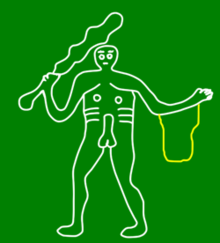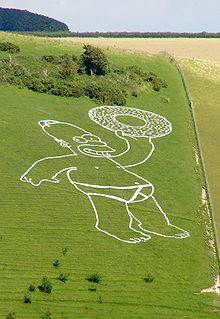- Cerne Abbas Giant
-
The Cerne Abbas Giant, also referred to as the Rude Man or the Rude Giant, is a hill figure of a giant naked man on a hillside near the village of Cerne Abbas, to the north of Dorchester, in Dorset, England. The 180 ft (55 m) high, 167 ft (51 m) wide[1] figure is carved into the side of a steep hill, and is best viewed from the opposite side of the valley or from the air. The carving is formed by a trench 12 in (30 cm) wide,[1] and about the same depth, which has been cut through grass and earth into the underlying chalk. In his right hand the giant holds a knobbled club 120 ft (37 m) in length.[1] A 1996 study found that some features of the image have changed over time; notably, the study concluded that the figure originally held a cloak in its left arm and stood over a disembodied head.[2]
The figure's origin and age is unknown. Early antiquarians associated it with a Saxon deity, though there is little evidence for such a connection.[3] Other scholars sought to identify it with a Celtic British figure or the Roman Hercules, or some syncretization of the two.[4] The 1996 discoveries strengthened the identification with Hercules, who was often depicted wielding a club and carrying a cloak made from the Nemean Lion.[4] However, since the first descriptions of the figure do not appear until the mid-18th century, many scholars conclude that it is not significantly older than that.[4] Regardless of its age, the Cerne Abbas Giant has become an important part of local culture and folklore, which often associates it with fertility.[4]
Contents
History
Like several other chalk figures carved into the English countryside, the Cerne Abbas Giant is often thought of as an ancient creation. However, as with many of the other figures, its history cannot be traced back further than the late 17th century, making an origin during the Celtic, Roman or even Early Medieval periods difficult to demonstrate. Above and to the right of the giant's head is an earthwork known as the "Trendle", or "Frying Pan". Medieval writings refer to this location as "Trendle Hill", but make no mention of the giant, leading to the conclusion that it was probably only carved about 400 years ago.[1][5] In contrast, the Uffington White Horse — an unquestionably prehistoric hill figure on the Berkshire Downs — was noticed and recorded by medieval authors.
The earliest written reference to the giant was made in 1694, in a record for payment in the Cerne Abbas churchwarden's accounts of three shillings toward the re-cutting of the giant.[1][6] The first survey of the giant was published in Gentleman's Magazine in 1764,[6][7] and in 1774, John Hutchins wrote in his book The History and Antiquities of the County of Dorset that the carving had only been done the previous century.[5]
Early antiquarians associated the figure with a Saxon god whose name contained some variant of the element Hel-.[3] This god is attested in several medieval and early modern texts, and was associated with the Cerne Abbas Giant by an editor of a 1789 edition of William Camden's Britannia and by William Stukeley, who indicated that locals referred to the giant as "Helis".[4] A Saxon origin is unlikely, but Stukeley was also the first to hypothesize that the figure was Hercules, a suggestion that has found more support.[4][8]
Proponents of a 17th-century origin suggest that the giant was carved during the English Civil War by servants of the Lord of the Manor, Denzil Holles, and was intended as a parody of Oliver Cromwell.[1] Cromwell was sometimes mockingly referred to as "England's Hercules" by his enemies. The Hercules connection is strengthened by the 1996 discovery of the cloak, as Hercules was often depicted with a cloak made from the Nemean Lion's skin.[4]
Nineteenth century sources describe the giant as having "between his legs, three rude letters, scarcely legible, and over them in modern figures, 748", (rude meaning "roughly cut")[9][10] and being the representation of Cenric, the son of Cuthred, King of Wessex.
In 1920, the giant and the 1 acre (4,000 m2) on which he sits was acquired by the National Trust and is listed as a Scheduled Monument.[11] During World War II the giant was disguised in order to prevent use as a landmark for enemy aircraft.[12]
According to the National Trust, the grass is kept trimmed on a regular basis and the giant is re-chalked every 25 years.[12] Traditionally, the National Trust has relied on sheep from surrounding farms to graze grass at the site.[13] However, in 2008 a lack of sheep, coupled with a wet spring causing extra plant growth, forced a re-chalking of the giant,[14] with 17 tonnes of new chalk being poured in and tamped down by hand.[15]
In 2003, Aubrey Manning investigated the date of the figure for his Open University programme Landscape Mysteries. He came to a conclusion that it is probably a cartoon of Oliver Cromwell and dates from the 17th century.[16]
Folklore
Whatever its origin, the giant has become an important part of the culture and folklore of Dorset. Some folk stories indicate that the image is an outline of the corpse of a real giant.[4] One story says the giant came from Denmark leading an invasion of the coast, and was beheaded by the people of Cerne Abbas while he slept on the hillside.[17]
Other folklore, first recorded in the Victorian era, associates the figure with fertility.[4] In the past locals would erect a maypole on the earthwork, around which childless couples would dance to promote fertility.[7] According to folk belief, a woman who sleeps on the figure will be blessed with fecundity, and infertility may be cured through sexual intercourse on top of the figure, especially the phallus.[4]
Appearance
In 2008, a group of archaeologists using special equipment found that part of the carving had been allowed to be obliterated.[18] According to these findings, the free arm should have held a depiction of an animal's skin, giving credence to the theory that the giant was a depiction of a hunter, or alternatively, Hercules with the skin of the Nemean lion over his arm. It has also been suggested that his large erection is, in fact, the result of merging a circle representing his navel with a smaller penis during a Victorian re-cut.[19]
Publicity stunts
Homer Simpson as promotion for The Simpsons Movie.
In modern times the giant has been used for several publicity stunts and as an advertisement for "...condoms, jeans and bicycles."[12] A low-key example was the sponsorship of the 1983 scouring by the brewers Heineken. As a publicity stunt for the opening of The Simpsons Movie on the 16 July 2007, a giant Homer Simpson brandishing a doughnut was outlined in water-based biodegradable paint to the left of the Cerne Abbas giant. This act angered local neopagans, who pledged to perform rain magic to wash the figure away.[20][21]
In August 2007 a report in the Dorset Echo said that a man claiming to be the "Purple Phantom" had painted the Cerne Abbas Giant penis purple. It was reported that the man was from Fathers 4 Justice but the group said that they did not know who it was.[22]
See also
- Long Man of Wilmington
- Gigantotomy
References
- ^ a b c d e f Cerne Abbas Giant at Sacred Destinations
- ^ Koch, John T. (2006). Celtic Culture: A Historical Encyclopedia. ABC-CLIO. p. 395. ISBN 1851094407.
- ^ a b Koch, John T. (2006). Celtic Culture: A Historical Encyclopedia. ABC-CLIO. pp. 395–396. ISBN 1851094407.
- ^ a b c d e f g h i j Koch, John T. (2006). Celtic Culture: A Historical Encyclopedia. ABC-CLIO. p. 396. ISBN 1851094407.
- ^ a b Hutchins, John (1973) [1742]. The History and Antiquities of the County of Dorset. Robert Douch (Contributor). Oxford: Rowman & Littlefield Publishers. ISBN 0874713366.
- ^ a b Haughton, Brian (2007). Hidden History: Lost Civilizations, Secret Knowledge, and Ancient Mysteries. Franklin Lakes, NJ: New Page Books. pp. 136. ISBN 1564148971.
- ^ a b Lewis, Richard (May 1, 2005). "Celebrating May Day the Pagan Way". The Observer. http://www.guardian.co.uk/travel/2005/may/01/unitedkingdom.culturaltrips.observerescapesection1. Retrieved 2008-06-20.
- ^ The modern antiquarian, Julian Cope, Thorsons 1998
- ^ Curtis, Thomas (ed.) (1829). The London Encyclopaedia: Or, Universal Dictionary of Science, Art, Literature, and Practical Mechanics, Comprising a Popular View of the Present State of Knowledge. Illustrated by Numerous Engravings, a General Atlas, and Appropriate Diagrams. Thomas Tegg. pp. 768. http://books.google.co.uk/books?id=7n9MAAAAMAAJ&pg=PA290&dq=%22trendle+hill%22&lr=&num=100&as_brr=1#PPA291,M1.
- ^ Britton, John, et al. (1803). The Beauties of England and Wales, Or, Delineations, Topographical, Historical, and Descriptive, of Each County. Thomas Maiden, for Vernor and Hood. http://books.google.co.uk/books?id=cqQMAAAAIAAJ&pg=PA483&dq=%22trendle+hill%22&lr=&num=100&as_brr=1#PPA483,M1.
- ^ National Trust carries out first ever Giant survey
- ^ a b c Cerne Abbas Giant
- ^ Cockcroft, Lucy (June 19, 2008). "Cerne Abbas giant in danger of disappearing". The Daily Telegraph. http://www.telegraph.co.uk/earth/main.jhtml?xml=/earth/2008/06/19/eagiant119.xml. Retrieved 2008-06-20.
- ^ BBC (June 20, 2008). "Sheep shortage hits Giant's look". BBC. http://news.bbc.co.uk/1/hi/england/dorset/7465329.stm. Retrieved 2008-06-20.
- ^ Morris, Steven (2008-09-16). "Volunteers restore historic giant of Cerne Abbas to his former glory". The Guardian (Guardian Newspapers). http://www.guardian.co.uk/artanddesign/2008/sep/16/heritage.ruralaffairs. Retrieved 2008-09-17.
- ^ "Landscape Myseries: Figures In The Chalk". The Open University. 2003. http://www.open2.net/landscapemysteries/prog2.html. Retrieved 2010-07-16.
- ^ Woolf, Daniel R. (2003). The Social Circulation of the Past: English Historical Culture 1500–1730. Oxford University Press. pp. 348, footnote 178. ISBN 0199257787.
- ^ "Cerne Abbas Giant & Cerne Abbas, Dorset". Weymouth & Portland Borough Council. http://www.weymouth.gov.uk/home.asp?sv=295. Retrieved 2010-10-03.
- ^ Grinsel, Leslie "The Cern Abbas Giant 1764–1980", Antiquity, Vol 54 No 210, March 1980, pp. 29–33 (2001 ed, p.73)
- ^ "Pagans have a cow over Homer". The Sun Online. 2007-07-16. http://www.thesun.co.uk/article/0,,2-2007320865,00.html.
- ^ "Wish for rain to wash away Homer". BBC News. 2007-07-16. http://news.bbc.co.uk/2/hi/uk_news/england/dorset/6901543.stm.
- ^ Giant daubed by 'vigilante'
External links
Categories:- Archaeological sites in Dorset
- Hill figures in England
- Scheduled Ancient Monuments in Dorset
- Visitor attractions in Dorset
- Dorset folklore
Wikimedia Foundation. 2010.





